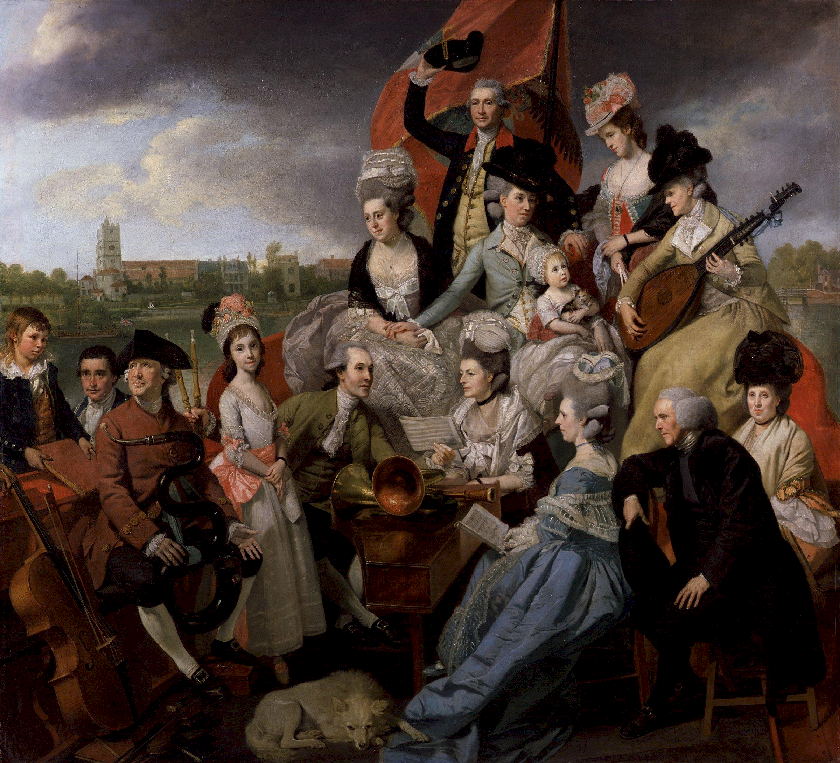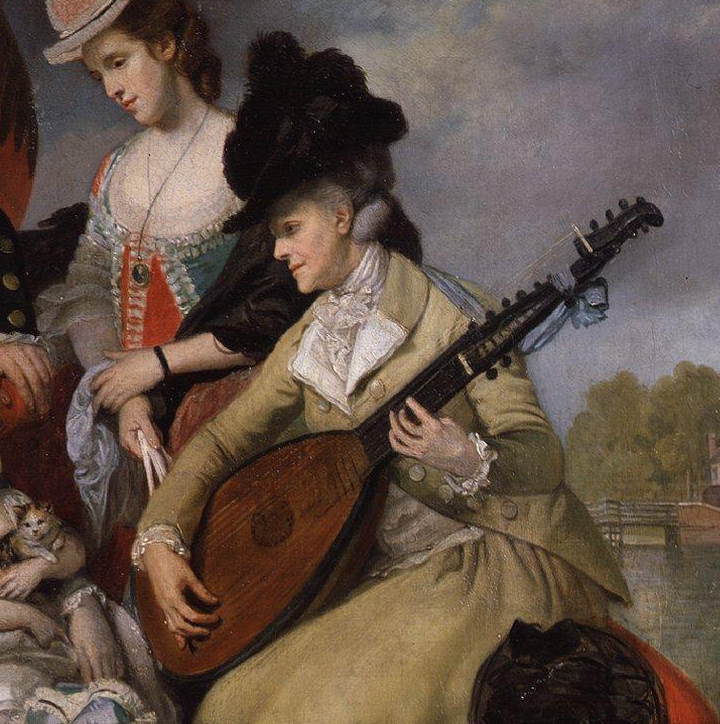

Johann Zoffany (1733 - 1810)
The Sharp Family (1781), oil on canvas 1156mm x 1257mm
The National Portrait Gallery, London, (number L169)

Johann Zoffany (1733 - 1810)
The Sharp Family (1781) Detail
|
This splendid painting of the Sharp Family on their barge Apollo on the River Thames near Fulham was commissioned by William Sharp, who is at the back raising his hat in greeting to the spectator, from the then fashionable portrait painter and member of the Royal Academy, Johann Zoffany.
Zoffany had come from his native Frankfurt to England in about 1758 and first worked as a decorator of clock faces before making his name in the fine art world.
The Sharp family held summer parties with music on their barge and here we see a carefully posed view of the gathering, almost like a triumphant military scene with that great red banner topping off the triangular pyramid of people. In fact it is very reminiscent of The Death of General Wolfe, 1770 by Benjamin West.
They are dressed in the height of fashion for the period but the instruments can hardly be said to be up to the minute. In fact it is rather an odd collection of instruments, and one can scarcely imagine them playing together as a complete ensemble. The cello on the left is apparently without a player so I assume it was the second instrument of the man who holds the serpent, both could have functioned as basso continuo instruments, though the serpent was by then distinctly old fashioned and more often heard in church bands. As later described by Thomas Hardy in Under the Greenwood Tree, remembering the times of his youth, only fifty years after this picture was painted: "Yet there's worse things than serpents," said Mr. Penny. "Old things pass away, 'tis true; but a serpent was a good old note: a deep rich note was the serpent"
The young man who holds a piece of music for the harpsichord player has a brace of oboes in his other hand; there is another oboe or maybe a clarinet together with a couple of horns lying on the harpsichord. Hardy again: "Clar'nets, however, be bad at all times," said Michael Mail. "One Christmas - years agone now, years - I went the rounds wi' the Weatherbury quire. 'Twas a hard frosty night, and the keys of all the clar'nets froze - ah, they did freeze! - so that 'twas like drawing a cork every time a key was opened;......" This clarinet is in no such danger on this fine summer's day!
Finally there is the lute, given pride of place both in its position in the painting and in the fact that it is almost the only instrument being actually played [the harpsichordist appears to have her hands on the keyboard]. It is a classic 13 course German baroque lute of the type that J. C. Hoffmann and Widhalm made in Leipzig and Nürnberg. There are suprisingly few pictures of this sort of lute considering the number that have survived in museums, but this painting fits the surviving lutes remarkably well. The overall body shape is very like the Hoffmanns. The rose, high and small is right, as is the ornate double pegbox whose curly shape lends itself to the tying of a supporting sash as shown here and also in the picture of Willoughby 4th Earl of Abingdon with a lutenist. (see note below)
I originally thought the lutenist might possibly be Haydn since the Earl of Abingdon took over organizing the Bach-Abel Concerts in 1782 after the death of Johann Christian Bach and he invited Haydn to London in 1783. However I have since (2019) found out from a very good essay by Derek McCulloch of the Café Mozart ensemble about Willoughby Bertie’s role in musical life that the lutenist is in fact Willoughby Bertie’s uncle Mr. Collins! Dr. McCulloch tells me he found this from
FACTS AND RECOLLECTIONS OF THE XVIIIth CENTURY IN A MEMOIR OF JOHN FRANCIS RIGAUD Esq., R.A.
by his son Stephen Francis Dutilh Rigaud, published in Volume 50 of the Walpole Society 1984. I have looked it up and there are two references:
You can download Dr. McCulloch’s article from a sidelink on a brief webpage about Willoughby Bertie put together by the Abingdon Area Archaeological and Historical Society. And in it he further remarks that the earl’s first collection of Six Songs and a Duet (published by subscription ca 1788) had a full page copy of Benedetti’s engraving on the inside cover.
None of the surviving lutes of this sort that I know of have a complete ivory upper nut as in the Zoffany portrait of the Sharp family but it seems an entirely likely detail. There is a black leather reinforcing lace round just the lower edge of the soundboard where it rests on the knee and an ebony edging to the soundboard elsewhere. The soundboard itself looks distinctly old with dark colour and worn patches, reminding us of the value placed on old instruments and particularly old soundboards by the time of the mid 17th century. In 1676 Thomas Mace was writing about how valueable Laux Maler lutes were, however badly worn "First, know that an Old Lute is better than a new one: .....two of which lutes I have seen (pittifull old, Batter'd Crack'd things) valued at 100 pounds each." The body appears to be made of alternate black and white ribs, perhaps ebony and ivory. Interestingly, there is an ivory German baroque style 13 course lute in the Victoria and Albert Museum made by Michael Rauche in 1762 in London; only 19 years before this painting and possibly the only historical lute made in England to have survived.
The indomitable looking elderly lady playing the lute reminds me of paintings of Daughters of the American Revolution and the central figure has somewhat the air of George Washington rallying the troops which is ironic since 1781 is the very year that he won the climactic Battle of Yorktown in the American War of Independence. While the English upper middle classes were having musical parties in barges on the Thames!
|
| Lutes | Bows | |
| History of the Lute | Build your own Baroque Lute | Build your own Renaissance Lute |
Copyright 1998 by David Van Edwards